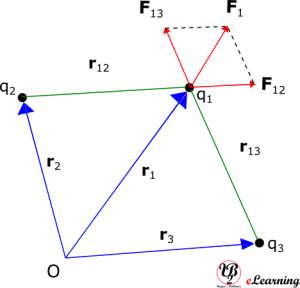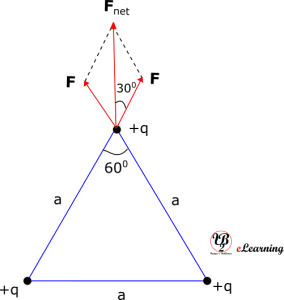Forces Between Multiple Charges – Principle of Superposition
Principle of superposition
Force on any charge due to a number of other charges is the vector sum of all the forces on that charge due to the other charges, taken one at a time. The individual forces are unaffected due to the presence of other charges.
Explanation
Note: Here we are using bold letters to represent vectors.
Consider a system of three charges q1, q2, and q3 with position vectors r1, r2, and r3 respectively as shown in Fig. 1. The forces on q1 due to q2 and q3 are given by F12 and F13 respectively. The resultant force F1 on q1 is the vector sum of F12 and F13. The vector sum can be obtained by parallelogram law of vector addition.

By Coulomb’s law of electrostatic force, force on q1 due to q2 in free space or vacuum is given by
Similarly, the force on q1 due to q3, is given by
The resultant force F1 on q1 due to q2 and q3 is the vector sum of these two forces. It is given by
Like that if there are n charges and the force on charge q1 due to all other charges is given by
Numerical
Q. Calculate force on any charge q, if three equal and similar charge +q is placed at the edges of an equilateral triangle.
Solution:

Force on one charge due to other two charges are given by Coulomb’s law of electrostatic force. Since charges are same which is q, and distance between them are also same as they are placed at the sides of equilateral triangle. So, forces are same in magnitude and is given by,
Direction of forces are as shown in Fig. 2.
The resultant force is the vector sum of these two forces, the magnitude of the net force is given by the equation,
We also know, if the vectors with equal magnitude makes an angle with each other, then the resultant vector will bisect the angle between them. That is the resultant vector makes an angle
from both vectors.
Here angle between the vectors is 600, therefore, the resultant force makes an angle 60/2 = 300 from both forces.
